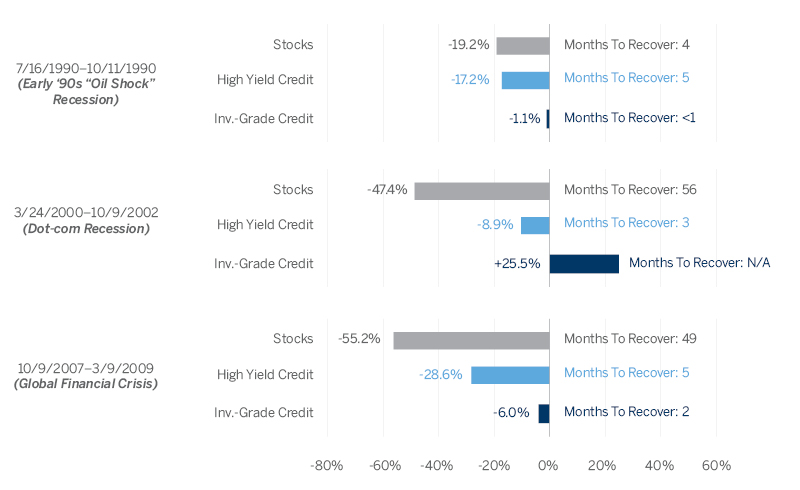Anyone who has read or watched “Game of Thrones” over the years is familiar with the phrase, “Winter Is Coming.” In the books and on the show, long cycles of warm weather are followed by lengthy winters that can last many years. No one can predict when those winters will arrive, or how long they will last.
That metaphor is particularly fitting for economic and credit cycles. Every cycle of growth resolves with a contraction eventually, but it is very difficult to time precisely when credit or equity markets might turn, or how long it might take either market to recover.
Many market observers fear that a turn in credit markets is coming, and are fleeing away from credit risk and toward cash and other safer investments. However, we think that investors may miss an opportunity if they compare credit risk vs. cash; we think it is more helpful to view credit risk as an alternative to the stock market—especially given the challenge of guessing exactly when markets may turn. Investors in corporate credit are generally looking at the same risks as equity investors, and during times of economic or company-specific stress, value tends to shift “up” the capital structure—i.e., away from a company’s equity and towards its debt obligations.
As we discuss in this article, we believe that credit naturally plays a complementary role with equities in portfolios, and that this pairing can be particularly fruitful during cyclical downturns. In our management of fixed income portfolios with meaningful corporate credit exposure (Core Fixed Income, Sustainable Core and Strategic Bond), we support our clients’ allocations to credit with intense due diligence on individual securities, in an effort to ensure that our holdings are robust enough to withstand stressed market conditions.
How Has Credit Held Up Through Default Cycles
Over the past several decades we have seen three major periods marked by market downturns and default cycles—1989-90, 2000-02, and 2007-08. In each case, investors that were heavily weighted in equities fared worse than those who spread their risk budget across equities, high-yield credit and investment-grade credit. Those with a balanced approach generally mitigated downside capture during the worst periods, and recovered from losses more quickly in subsequent periods (see chart below).
Importantly, we believe that during stressful periods, research and due diligence is absolutely essential to successful credit investing. With a robust process, we seek out specific credits that can weather stormy conditions and thrive when other credits falter. We believe that this process can greatly enhance our results during contractions and recoveries.
Dynamic Positioning
Our process seeks to generate credit alpha without resorting to market timing. Our research effort is based on deep fundamental research on individual securities, and we insist that every investment we hold in our portfolios serve a distinct purpose. In some situations, we may be looking to bolster portfolio stability to counteract potential macro or sector-specific headwinds. In others, we may be looking to capitalize on spread compression, if we believe that a problematic bond’s situation is likely to be resolved, thereby unlocking its value. In each case, the role that the bond is expected to play in the portfolio helps determine the parameters we will use to make decisions about that bond.
“WINTERPROOFING” YOUR PORTFOLIO
During the last three cyclical downturns (marked by recession and increased default levels, as well as equity-market declines), a balanced investment in equity and credit would have outperformed an equity-only allocation. Investment-grade credit provided near-total downside protection relative to equities during these periods. High-yield credit offered minimal protection during the “quick” recession in 1990, but performed much better than equities, and recovered much more quickly, in the two protracted downturns of the 21st century.
Source: Bloomberg. Stocks, high yield credit and investment grade credit are represented in the chart by the S&P 500 Index, the Bloomberg Barclays U.S. Corporate High Yield Bond Index, and the Bloomberg Barclays U.S. Corporate Bond Index, respectively. Please see the end of the article for a complete list of index definitions.
Our research revolves around three essential steps:
- Test for cash flow resilience. Each of our credit decisions hinges on an assessment of an issuer’s ability to support its obligations to bondholders in difficult conditions. Can an auto supplier sustain its free cash flow when production declines, demand falters, or evolving technology requires new investment? Can a packaging supplier successfully pass through rising raw material costs?
We evaluate each situation with classic financial tools such as statement analysis, data-driven modeling, and sensitivity testing and scenario analysis. We aim to reproduce a full likely range of probable market and issuer scenarios, and we use those data points to paint a robust picture of expected outcomes that informs each investment decision and drives portfolio sizing. - Test enterprise valuation. Once we are comfortable with an issuer’s business model, we can turn our attention to valuation of securities across the capital structure, and understand the relative strength of our potential position within that structure. Risk and value are linked but ultimately separate factors. A credit with a low loan-to-value ratio may be a safe investment, but offer little to no return potential; meanwhile, a highly levered credit may offer compelling value vs. comparable options if it is backed up by a resilient business model. The goal here is to find the spot in the capital structure that offers the most compelling valuation relative to embedded risk.
- Test the worst-case scenario. The worst-case scenario for most credit investments is a default, in which a company has run out of cash, business prospects and options and seeks to restructure its obligations—often under bankruptcy protection. Expecting this downside is central to understanding whether risk is appropriately priced into a bond. The sharper our pencil is as we seek to estimate a bond’s recovery value from a potential default, the more able we will be to spot value, or lack thereof, in that bond.
We use bankruptcy waterfall analysis and other tools to estimate worst-case recover value. Some bankruptcy scenarios are fairly straightforward, but in negotiated scenarios it can be hard to estimate recovery values, because the mix of cash and securities a bondholder may receive is entirely subject to the negotiation process. In such instances, we use historical precedent, debt covenants specific to the bond in question, and other information to help us in our effort to refine our estimates.
In short, we seek to arm ourselves with an understanding of the probability of a bond’s default, and our likely loss given a default. Using that analysis, we can determine whether bonds at various seniority levels offer value, in our view, above and beyond their risk profiles. This philosophy drives much of our decision making across our fixed income strategies, and especially for strategies with meaningful corporate exposure such as Core Fixed Income, Sustainable Core and Strategic Bond. (Strategic Bond is a broad credit strategy with notable high-yield exposure, making bottom-up research that much more important to its success.)
In these strategies, we are currently “underweight beta and overweight alpha”—a shorthand way of saying that we are steering away from duration risk, and focusing more on informed investments in bonds that offer value both today and in apotential future downside scenario. We are also extremely focused on determining the level within a capital structure that offers us the most value—while a lower-seniority investment may carry higher absolute risk, it may also present a more compelling value depending on its valuation.
Finding robust issuers, and selecting the sweet spot in the capital structure, can help us in our effort to maximize risk-adjusted returns at all points during the credit cycle—the ultimate goal for any active, fundamental credit investor. We may not be able to predict when winter is coming, but we can be prepared for it and make the most of our opportunities when it comes. 
The views expressed are those of Brown Advisory as of the date referenced and are subject to change at any time based on market or other conditions. These views are not intended to be and should not be relied upon as investment advice and are not intended to be a forecast of future events or a guarantee of future results. Past performance is not a guarantee of future performance and you may not get back the amount invested.
The information provided in this material is not intended to be and should not be considered to be a recommendation or suggestion to engage in or refrain from a particular course of action or to make or hold a particular investment or pursue a particular investment strategy, including whether or not to buy, sell, or hold any of the securities mentioned. It should not be assumed that investments in such securities have been or will be profitable. To the extent specific securities are mentioned, they have been selected by the author on an objective basis to illustrate views expressed in the commentary and do not represent all of the securities purchased, sold or recommended for advisory clients. The information contained herein has been prepared from sources believed reliable but is not guaranteed by us as to its timeliness or accuracy, and is not a complete summary or statement of all available data. This piece is intended solely for our clients and prospective clients, is for informational purposes only, and is not individually tailored for or directed to any particular client or prospective client.
The S&P 500® or Standard & Poor’s 500 Index is a market-capitalization-weighted index of the 500 largest U.S. publicly traded companies. The Bloomberg Barclays U.S. Corporate High Yield Bond Index measures the USD-denominated, high yield, fixed-rate corporate bond market. The Bloomberg Barclays U.S. Corporate Bond Index measures the investment grade, fixed-rate, taxable corporate bond market. It includes USD-denominated securities publicly issued by US and non-US industrial, utility and financial issuers. Standard & Poor’s, S&P, and S&P 500 are registered trademarks of Standard & Poor’s Financial Services LLC (“S&P”), a subsidiary of S&P Global Inc. Bloomberg Barclays Indices are trademarks of Bloomberg or its licensors, including Barclays Bank PLC. BLOOMBERG, BLOOMBERG PROFESSIONAL, BLOOMBERG MARKETS, BLOOMBERG NEWS,BLOOMBERG ANYWHERE, BLOOMBERG TRADEBOOK, BLOOMBERG BONDTRADER, BLOOMBERG TELEVISION, BLOOMBERG RADIO, BLOOMBERG PRESS, BLOOMBERG.COM and BLOOMBERG LAW are trademarks and service marks of Bloomberg Finance L.P., a Delaware limited partnership, or its subsidiaries.

